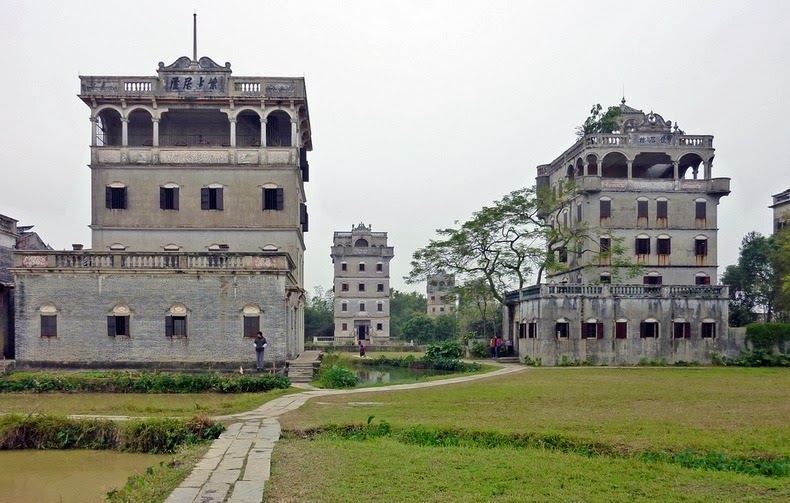Throughout Kaiping County in China, are scattered hundreds of fortified multi-storey towers called Diaolou. Built of stone, brick or concrete, these buildings represent a complex and flamboyant fusion between Chinese and Western architectural styles. During the Qing Dynasty of late 19th and early 20th centuries, these buildings were used as temporary refuge by several families or residential towers by individual rich families and as fortified residences, and watch towers. During the 1920s and 1930s, there were more than three thousand of these structures. Today, approximately 1,833 Diaolou remain standing in Kaiping, and approximately 500 in Taishan. 20 of the most symbolic ones are inscribed on UNESCO’s World Heritage List.
The area that is now Kaiping, traditionally belonged to the Yue people and the Han people who came in from the Central Plains of China and intermingled with the indigenous population. They cultivated rice and fished. From the mid 16th century, many villagers began to engage in trade on the nearby coast, sailing in wooden junks to south-east Asia. By the early 19th century, these poor farmers have started to travel to as far as America, drawn by the lure of the gold rush. As the 19th century drew to a close, the Chinese community had begun to amass large savings, and after the first World War, with rapid economic expansion in many countries, the fortunes of the overseas Chinese steadily improved. What they did not believe they had achieved however, was social recognition for their input into the expansion of the countries they had chosen to live in. Their dreams came to be associated with contributing to the wellbeing of their ancestral villages or returning to live there, and many did just that building conspicuous tower houses.
The influx of wealthy people attracted the attention of the bandits who raided, robbed and kidnapped. In response to increasing raids by bandits coming in from the north into the area along the rivers, the villagers begun to construct fortified towers. Of the 1833 Diaolou in Kaiping, 1648 were built between 1900 and 1931, just under 90% of the total. In the same period most of the villages were built or rebuilt. In the short space of 30 years the rural landscape of Kaiping was completely transformed with funds from overseas Chinese.
The Depression of the 1930s, and the war against Japan and the Pacific war of the 1940s brought development of Diaolous to a halt. Between 1943 and 1947 immigration control in the USA and Canada was abolished with the result that many Chinese moved back to North America. After the establishment of the People's Republic of China in 1949, banditry was halted and flood mitigation measures were introduced. With that the role of the Diaolou disappeared. In the 1980s following the re-opening of China, many villagers moved away. Now many Diaolou are empty, cared for by caretakers, but still regarded by overseas Chinese as their spiritual home to which they return on family occasions or remit money for prayers to be said to their ancestors. Some still contain all their original furniture and fittings.
Also see: Fujian Tulou: Ancient Earthen Castles of China






















I had really wondered about those when I'd come across them on bike trips. Thanks!
ReplyDeletemy mother grew up in one.
ReplyDelete